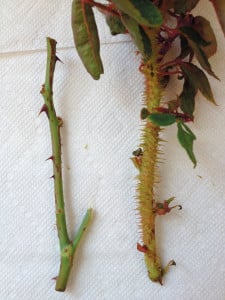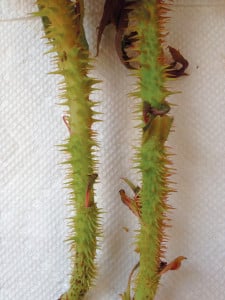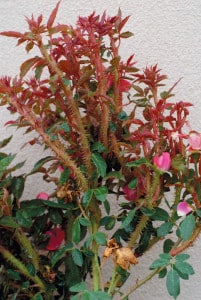Rose Virus That Produces Excess Of Thorns, Misshapen Leaves Found In Louisiana
By Karla Wall
State horticulture experts caused a bit of a stir in Louisiana’s rose gardening community earlier this month when they related the first reporting of the Rose Rosette Disease, a viral infection that attacks ornamental rose bushes, in the state in Bossier City.
As of now, says Dr. Raj Singh, assistant professor and state diagnostic specialist with the LSU AgCenter, the Bossier City case remains the only one in the state.
But that doesn’t mean local rosarians shouldn’t be keeping an eye on their plants.
A Long And Well-Traveled History

The disease is transmitted by microscopic eriophyiad mites called Phyllocoptes fructiphilus, four-legged, yellow-to-brown bugs which are about four times smaller than the tiny spider mite. Though wingless, P. fructiphilus can fly; they’re often carried from plant to plant and from region to region on the wind, meaning that weather systems can bring the disease to previously uninfected areas. The mites, once landed on a plant, carry the virus throughout the plant, as they feed on the sap of the stems.
The disease is also often transmitted through grafting.
RRD is transmitted mainly in populations of wild roses, or R. multifolora, which grow along roadways, or are used as natural hedges or erosion control on home properties. A modern ornamental rose with the common name of Knock Out Rose, is also very susceptible, though it was developed as a disease-proof cultivar.
The Knock Out Rose’s susceptibility to RRD has led to the belief that the disease has been spread through it, as well as wild roses, but, experts point out, the Knock Out Rose has been around only since 2000, well after RRD was established and spreading. And the popularity of the Knock Out Rose naturally means a high number of those plants will present with the disease. But RRD is no more prevalent in this type of rose than in any other. All species, from older heirloom species to more modern, can be and are infected.
Witch’s Broom

Also, new and infected canes tend to be thicker than “parent canes.”
The P. frucitiphilus mite prefers softer, younger foliage at the top of a plant, so that’s where you will normally see the first signs of infection. At first, you may notice only one cane infected, as RRD spreads very slowly.
Other symptoms to watch for include:
• An abnormal red color in shoots and foliage
• Distorted or dwarf leaves
• Abnormal flower color
• Spiral cane growth
• Deformed buds and flowers
• Clusters of shoots from single point on parent canes.
Singh points out that while symptoms are reliable, positive confirmation of RRD can only come from molecular testing.
Keep in mind, also, that RRD-like symptoms can also point to other conditions caused by other diseases and pests, including chili thrip infestation, which can also cause discoloration and distortion of leaves.
Prevention
Since RRD can literally be spread on the wind, there’s no foolproof means of prevention, and no garden is completely invulnerable. But there are ways to minimize your risk.
First, check to see if there are any multiflora, or wild roses, near your yard or garden. If so, remove them, and destroy them, preferably by burning.
You can use miticides, or more environmentally friendly products such as oils and insecticidal soaps, but make sure to treat the underside of leaves.
Periodically hitting the plants with a hard spray of water to knock mites off can also help.
There are also predatory mites to consider.
Periodic trimming might also help, since mites tend to live and feed in new growth.
Is There A Cure?
In a word? No.

Some experts say you stand a very small chance of saving the plant if you do some judicious pruning. As stated earlier, RRD spreads very slowly, and it travels from the top of the infected cane, to the base of the plant, and back up to the rest of the plant. It doesn’t spread leaf to leaf, unless by chance the mites jump from leaf to leaf, which normally doesn’t happen.
So you might, if you see symptoms of RRD at the top of a cane, follow it all the way to the ground and cut it out entirely. If you can do this before the virus spreads to the bottom of the cane, preventing it from going back up to the rest of the plant, you may be able to save the rest of the plant; but it may take a year or more before you know for sure.
And you must be sure to disinfect your pruning shears with bleach before using them again.
If you suspect RRD, however, your first step should be to contact Singh at the LSU AgCenter at 225-578-4562 or rsingh@agcenter.lsu.edu. The AgCenter is trying to observe the spread of the disease, and will welcome information on new infections.
As of now, says Singh, experts are simply trying to keep track of the disease, educate the public about it, and research effective management practices.
And, says Singh, “several universities and rose companies are working to develop roses that are resistant to the disease.”

















Comments are closed.